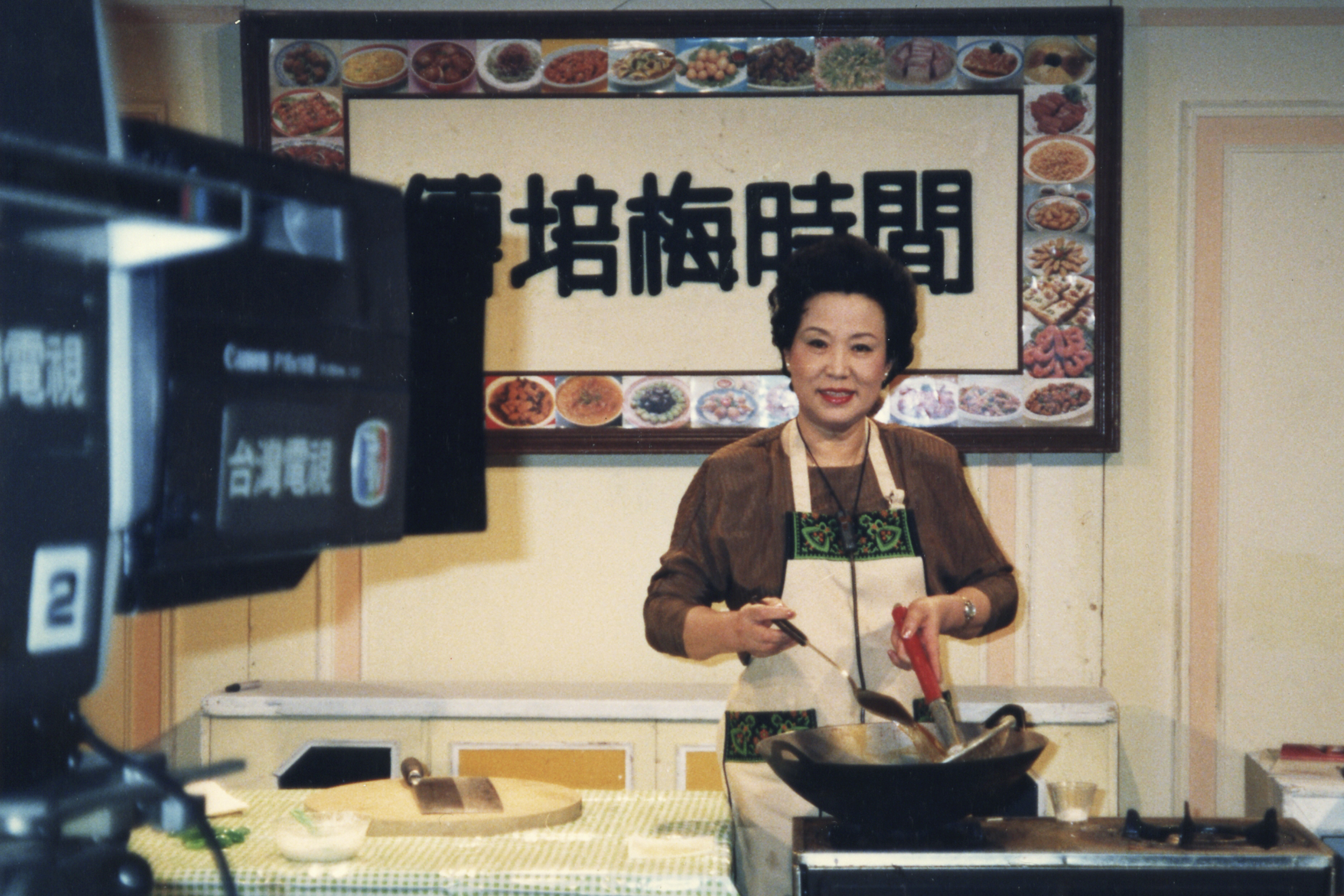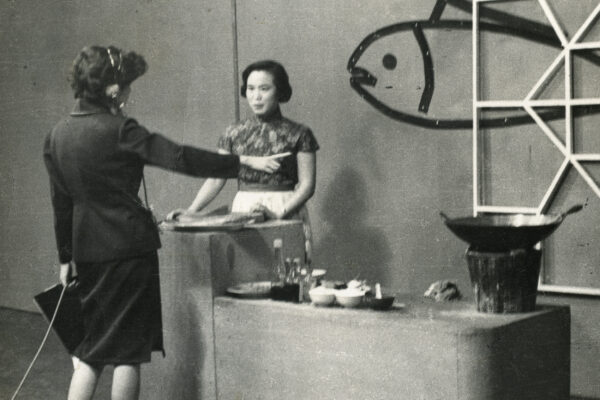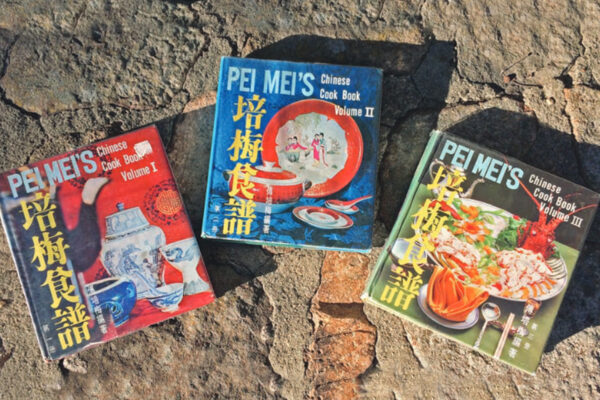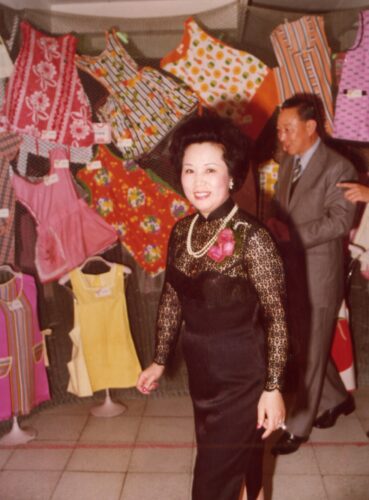Michelle King’s childhood memories are filled with the images and tastes of delicious Chinese recipes. While she grew up in Midland, Michigan, her parents cooked a large Chinese meal for their family each night, occasionally pulling recipes from the technicolor volumes of Fu Pei-mei’s bilingual cookbooks. Those same books now reside on King’s kitchen shelf, used to craft recipes to feed her own children. Beyond the volumes’ valuable instructions and advice, King, an associate professor in the UNC Department of History and a second-generation Chinese American, has come to appreciate the enormous legacy of one of modern Asia’s most prolific cooking personalities and cookbook authors.
Fu Pei-mei was born in China in 1931 and moved to Taiwan in 1949. She wrote more than 30 books on Chinese cuisine and produced and hosted cooking programs on Taiwanese and Japanese television. An original copy of her books today fetch upward of $100. Western audiences may understand her as the Julia Child of Chinese food, but Fu’s enduring impact begs whether it is actually Child who was the Fu Pei-mei of French food. Fu’s cookbooks, shows, classes, media appearances, and her Chinese autobiography have made her a staple in Taiwanese culture. She also traveled around the world and gave cooking demonstrations in Korea, Hong Kong, Japan, Singapore, South Africa, and Europe.
King was first drawn to her mother’s old cookbooks, and the larger topic of Chinese food and identity, after she faced particular challenges in writing her previous book on female infanticide in 19th-century China. In that research, she found that women’s voices were often unheard in primary texts — not an unfamiliar problem for a gender scholar.
[row]
[column lg=”6″ md=”12″ sm=”12″ xs=”12″ ]
[/column]
[column lg=”6″ md=”12″ sm=”12″ xs=”12″ ]
[/column]
[/row]
“It was all on what men thought of infanticide, specifically female infanticide. There were very few documents written or authored by women,” she says. “For my next book, I wanted to write about something where women’s voices are heard front and center.”
Within the pages of Fu’s well-worn cookbooks, King found what she had been looking for.
“Gender is so central to the notion of feeding our families, like gender roles and norms, and what people’s expectations are,” she explains. “Food is a way to talk about a lot of complicated things in a tangible way that people can really understand and relate to.”
Fu’s work not only tells the story of culinary tradition and diffusion through a woman’s perspective, but also ties in the complex history of Taiwan and identity through the concept of culinary nationalism. In her exploration of Fu’s life through her book, King explores a much larger narrative on Chinese culinary traditions, immigration, diaspora, and identity in the 20th century.
“I just love the way that food enables me to talk about so many different ideas,” King says.
A cook that stirred the pot
Starting in the 1960s, Fu was a culinary ambassador for the Republic of China in Taiwan. Beyond her books, classes, and travels, she was famous in Taiwanese households for her televised cooking demonstrations, which began in 1962 and continued until her retirement 40 years later.
“She was like Julia Child and then some, because she was the only one in Taiwan,” King explains.
Fu’s career began in the 1950s, when she explicitly taught cooking to housewives. Her work continued to transform alongside her audiences through the 1970s feminist movement in Taiwan, as women joined the work force and had less time to cook.
“So it really spans this entire sea of change in the way women are envisioned by their families and in their society,” King says. “That’s another really neat change that I can literally map onto this woman’s life and career to illustrate a much larger theme.”
Fu’s books are notable for their inclusion of English translations. They allowed her cooking to reach foreign audiences during an era when mainstream Western culture was just beginning to get a taste for Chinese cuisine.
“She was attempting to appeal not just to a domestic audience of housewives in Taiwan, but all along her entire career she very much had in mind a much broader, global audience,” King says.
Taiwan of the 20th Century
Taiwan, officially the Republic of China, is an island and country in East Asia. It evolved into the country it is today after the Chinese Communist Party and leader Mao Zedong assumed power on the mainland in 1949. The defeated Chinese Nationalist government fled to Taiwan.
There was never any formal settlement of hostilities, and for decades both the Communists and Nationalists claimed to be the legitimate government of China proper. During the Cold War, most Western nations had diplomatic relations with Taiwan (then known as “Free China”) and not mainland China (often called “Red China”). This changed dramatically in the 1970s, as the United Nations, United States, and other countries established formal diplomatic ties with mainland China.
Taiwan’s sovereignty remains contested by mainland China, which claims it as a province. No country wishing to have a diplomatic relationship with China may have formal diplomatic ties with Taiwan, which has resulted in international isolation for Taiwan and no representation at international bodies such as the U.N. Despite this, Taiwan is one of Asia’s major economic players and urban centers.
In the 1950s and ’60s, most of the world considered Taiwan as the legitimate representative of the Chinese government, while mainland China was isolated and consumed by internal political turmoil.
“So anything anyone knew about Chinese food in those years was coming out of places like Taiwan or Hong Kong or Singapore,” King explains. “There were no cookbooks that foreigners would know about that were published in mainland China in those decades.”
Through Fu, King recognized an opportunity to introduce American readers to the story of a country that many know little about, and from a gendered perspective. Fu was among a group of women who, during an era of migration from China, changed the way that Americans thought about Chinese food.
Notably, Fu had an early American audience in U.S. military families stationed in Taiwan. Her cooking classes for U.S. servicemen’s wives were part of the inspiration for the English translations. This connection to the U.S. military in Taiwan reveals a uniquely gendered, often overlooked aspect of the two countries’ Cold War arrangement and how culinary figures like Fu contributed to its cultural exchanges.
Old recipes for new generations
The population of Chinese immigrants in the U.S. exploded in the 1960s as a result of new immigration policies, which allowed more skilled workers and their families to enter the country from Asia. In one decade, the Chinese American population in the U.S. nearly doubled, and the Chinese American community demographically altered as more immigrants arrived from urban areas like Taiwan and Hong Kong.
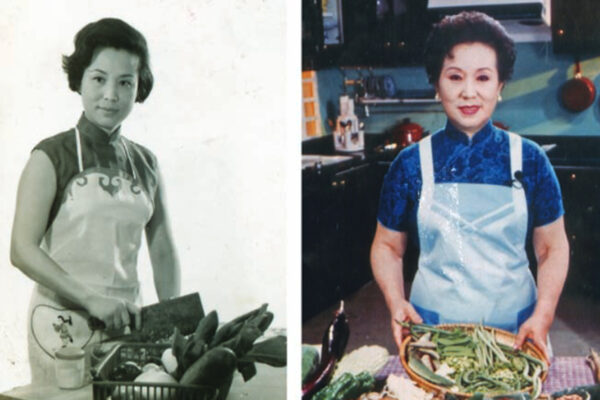
Fu hosted television cooking shows that made her a household name in Taiwan for 40 years, from 1962-2002.
In her research and teaching, King aims to address misconceptions and stereotypes around the culture of Chinese cooking. “We tend to think about Chinese cooking as this traditional inheritance, a kind of cultural thing that Chinese people just know,” King says.
While King credits her mom as being an exceptional cook, she says her mother had to learn her skills. King’s mother was never taught to cook as a young woman and focused instead on her studies. She learned to cook Chinese food after arriving in the United States in the 1960s and getting married, turning to Fu’s cookbooks for culinary knowledge.
“It’s not just that you learn how to cook at the knee of your grandmother or your mother,” King explains. “Those weren’t really available for various reasons including war, a separation of generations, and middle-class housewives becoming the norm rather than extended families. A lot of women in Fu Pei-mei’s generation, including Fu Pei-mei herself, did not know how to cook and so they had to learn.”
The diversity of a dish
King ties in the concept of national identity and its link to food in her broader scholarly work around culinary nationalism — the concept of countries using food and cuisine as a tool to build national support. In previous articles and a book King edited on the subject, she explores how culinary nationalism in China is as much defined by history and politics as by ingredients.
Culinary regionalism also exists globally. Focused on specific parts within a nation, it can be found in debates over the supposed seven culinary regions of Mexico and in the unique foods of the 28 states in India. In the United States, regional dishes vary widely, from Maine lobster to North Carolina barbeque.
While such regional divisions throughout the world are hotly debated, both scholarly and popular consensus typically agree on the same four “great” regional cuisines in the People’s Republic of China — although they are sometimes divided further into eight, 10, or 12. The cuisines represent northern, eastern, southern, and western regions of China: Lu from Shandong Province, Huaiyang from Jiangsu Province, Yue from Guangdong Province, and Chuan from Sichuan Province.
But the divides, King says, are nowhere near that simple. She was fascinated by how and when the strictly divided culinary regions of China came to be accepted. Her research found that the four regions are actually a more modern idea than once thought, perhaps developing even as late as the 1980s.
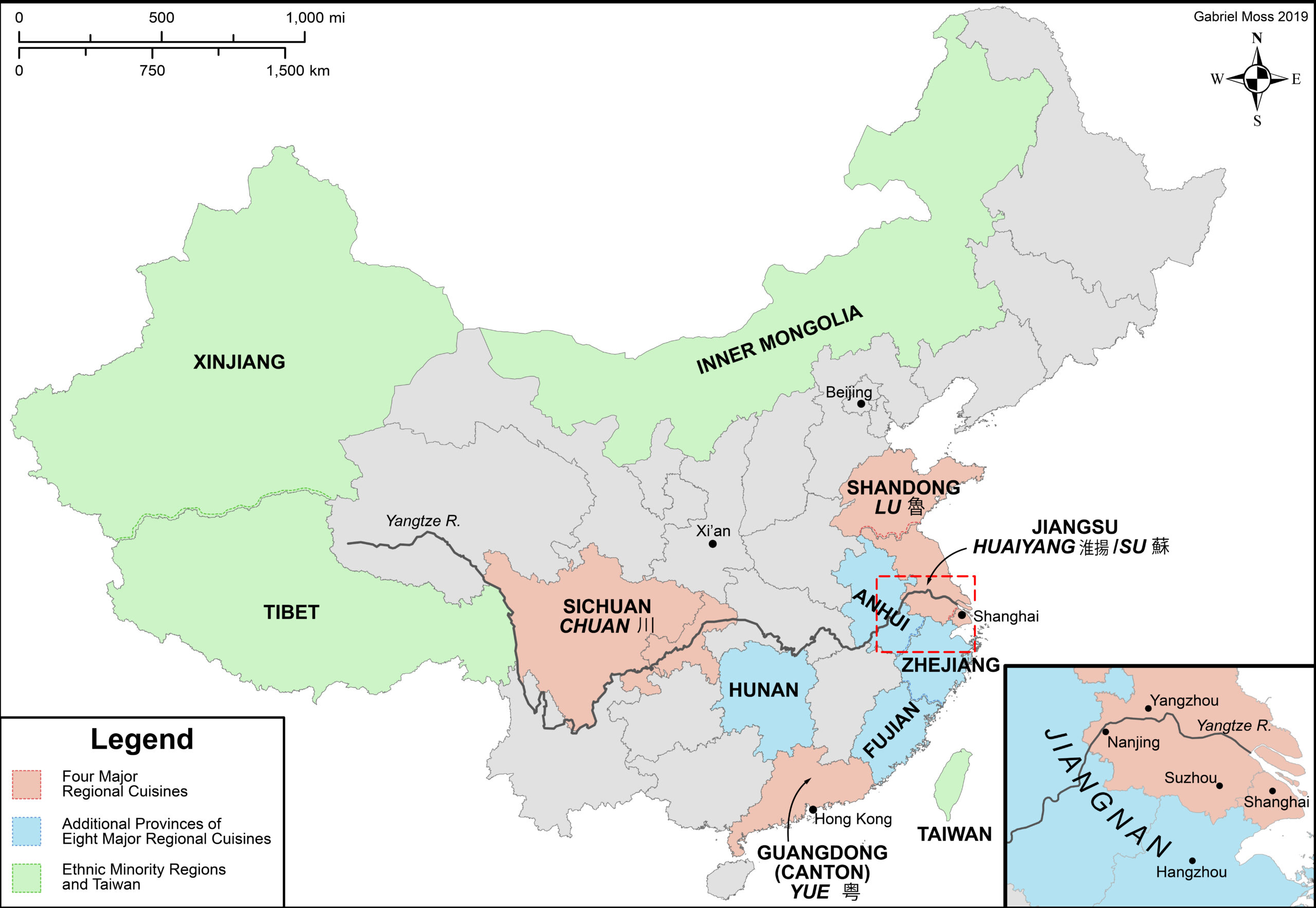
A map of China’s four and eight major culinary regions, Taiwan, and ethnic minority regions. (map by Gabriel Moss, mossmaps.wordpress.com)
Critically exploring how consensus on Chinese food and its regions was formulated is important to developing a Western audience’s limited picture of Chinese food. King points out that China is about the same size Europe, so the concept of Chinese food as a broad category, let alone as four distinct regions, is akin to encompassing Spanish gazpacho and Scandinavian meatballs in the single category of “European food.”
“Chinese food encompasses the takeout stuff that people are familiar with, but that is just like one small scratch of what Chinese food is,” King says.
Food for thought
This diversity of Chinese cuisine is something King wants her students to understand. It’s the food, she says, that hooks students, and around food she teaches them about history, migration, and how tastes move with people and cultivate belonging.
King’s broader study of Chinese food incorporates debates around authenticity and appropriation of national cuisines. In an honors seminar, King’s students explored cuisine and culture alongside immigrant experiences in interviews with Chinese restaurateurs in North Carolina. What they found was that authenticity and a love of cooking, while important, was typically outranked by economic necessity.
Chinese people engage in the restaurant industry for many reasons, King says. Like most immigrants, they are barred from jobs due to language barriers. “People are making food that will sell. That is the bottom line. These are businesses that people need to sustain their families and themselves,” King explains.
King has had students whose parents came to the U.S. and opened Chinese restaurants to ensure their children had exceptional opportunities in education and work. “I think a lot of people who are second-generation immigrants from wherever, not just China or Asia but from all over the world, are really interested and in tune with the idea of food as being a huge and important vehicle of their identity,” King says.
King hopes that her work contributes to a better understanding of the diversity of Asian American experiences. They are not all doctors and lawyers, she says, nor are they all restaurateurs. But the latter is still a major part of the story. She notes that studies have predicted a decline in the number of Chinese restaurants in the United States, as second and third generations of Chinese Americans are encouraged and supported by working parents to pursue higher education and careers, and new populations of immigrants from other countries introduce novel foods to American audiences.
Meals as memories
With two kids and a full-time job, King lacks the time to cook through all of Fu’s recipes, as much as she would love to. Her own experiences as a mother have helped her realize the devotion of her own parents to sharing Chinese recipes with their families.
“The thing that I have come to appreciate since having my own kids, is the fact that my parents cooked for us pretty much all the time,” King says.
She wants to teach her children how to make dumplings from scratch and recognizes that this experience as a second-generation Asian American is shared with many others. Although they live in a different world, King hopes her children get to experience some of those same memories of sight and taste and understand the richness of culture, connection, and history that is involved in Chinese food.
“One of the things I think about a lot is that my kids are not going to have that same experience of Chinese food that I have,” she says. “That’s a really huge part of how I grew up, my identity, and my connection with Chinese culture. I want to share that with them.”


